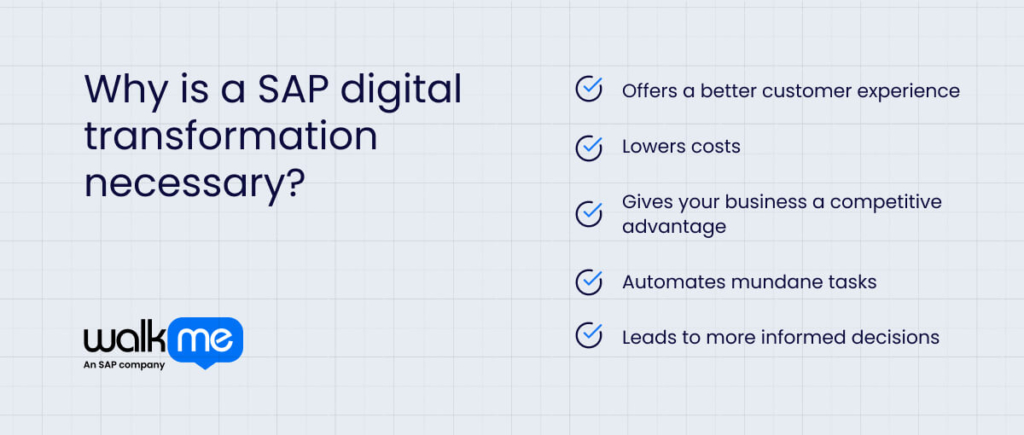Businesses can initiate a digital business transformation to enhance operations, reduce costs, and utilize resources more efficiently. By utilizing SAP tools, they can achieve this efficiency, gain real-time insights, and maintain adaptability.
However, to make a transformation work, a company must first define its goals, develop a clear plan, support employees through the changes, and continually improve over time.
A strong digital transformation framework helps businesses stay on track, no matter the reason for the change.
In this article, we’ll explain what SAP digital transformation means and why it matters. We’ll also examine who should be involved and outline the steps you need to take to ensure your transformation is a success.
What is SAP digital transformation?
A SAP digital transformation is a strategic initiative that helps businesses improve operations by using SAP tools across all departments. These tools provide teams with real-time data and analytics, enabling them to identify patterns and plan ahead. With clear insights, teams can respond quickly to customer needs.
SAP tools also enhance customer experiences by enabling teams to personalize services and foster stronger relationships. This enterprise transformation creates a shift in workplace culture, where employees learn new ways to think, work, and collaborate.
Businesses can utilize SAP solutions to automate tasks, minimize manual labor, and lower costs. These changes increase productivity and free up time for more valuable work. Companies also gain flexibility to adjust to market changes and explore new growth opportunities.
Tools such as SAP S/4HANA support this transformation by offering a real-time ERP system. SAP Signavio also helps teams improve and manage workflows by highlighting areas where they can work more efficiently.
Why is a SAP digital transformation necessary?

A clear reason for initiating an SAP digital transformation enables teams to set goals, align stakeholders, and deliver tangible business value. Without a strong ‘why’, employees may lose focus, invest in the wrong areas, and waste time and resources.
Here’s some more detail on why your company may need a SAP digital transformation:
Offers a better customer experience
SAP tools enable businesses to understand customer needs and deliver a more effective service. When teams connect data across platforms, they give customers a better experience. With the right data, teams can identify problems early and provide support. Its AI and automation features also let teams fix issues faster.
Lowers costs
You can achieve cost savings through a SAP digital transformation by improving how work gets done. For instance, a business can automate application implementation processes using tools like SAP Cloud ALM. Tools like SAP Test Acceleration and Optimization (TAO) can automate the creation of test scripts.
Gives your business a competitive advantage
Through digital transformation, companies can leverage digital tools across all business areas to respond more effectively to market changes. This is because when businesses have full access to data, they can develop a more effective plan for future needs. Faster processes and flexible systems also help them launch new products and services more quickly.
Automates mundane tasks
By utilizing digital tools to automate simple, repetitive tasks, SAP’s digital transformation enables employees to focus on more valuable work. For instance, SAP Build Process Automation combines workflows and RPA to help teams manage and automate tasks. This tool also features a low-code or no-code platform, allowing users to easily build and manage workflows.
Leads to more informed decisions
Businesses can closely examine their real-time data to identify useful trends and patterns using SAP tools. These insights can inform better decisions. With this data, companies can gain a deeper understanding of what customers want, refine their services, and encourage stronger customer delight.
Who is involved in a SAP digital transformation?

A clear understanding of who benefits from an SAP digital transformation helps guide planning and execution. Different teams have different needs for training, tools, and support.
Team leaders can use this insight to improve user experience and align the project with business goals. A deeper knowledge of stakeholder needs also supports more accurate ROI tracking and enhanced change management.
So here are examples of who you could involve in a SAP digital transformation:
IT professionals
Your IT team leads the transition and ensures a successful implementation during a SAP digital transformation. They connect business needs with technology, manage systems, protect security, and ensure operations run well.
End users
End users can take an active role in SAP’s digital transformation by sharing feedback, utilizing the new system, and assisting teams in its improvement. Their input boosts user adoption, reduces resistance, and increases project value.
Strategic leadership
You need strategic leaders to guide a SAP digital transformation by setting the vision, aligning it with business goals, and supporting teams through change. Without strong leadership, teams may lose focus and create little value.
Change management team
A change management team guides people through SAP digital transformation, helping them adapt to new systems. Their support increases digital adoption and ensures the business gains real value. Without their help, users may resist the change and cause the project to fail.
SAP external consultants
SAP consultants drive digital transformation by leveraging their expertise in SAP, process improvement, and change management. They align systems with business goals and help teams deliver a better customer experience.
How to implement a SAP digital transformation strategy
Clear steps are key to a successful SAP digital transformation. They help guide the process, ensuring it aligns with business goals and maximizes value from SAP tools.
A good plan also supports long-term growth and flexibility. Without a clear roadmap, companies may waste money and fail to see real results. Here’s how to implement a SAP digital transformation strategy within your company:
1. Assess your current IT and process maturity
A successful SAP digital transformation begins with a clear review of current IT systems, business processes, data quality, and workforce skills. The team should focus on integration, technology adoption, and process efficiency to build a strong foundation.
Leaders must set clear business goals, such as reducing costs or improving service, to guide their efforts. Stakeholders from across departments could share input to ensure alignment and support.
Your team should also assess technology, data, and business readiness to find areas for improvement. SAP tools, such as Signavio and S/4HANA assessments, help uncover valuable insights.
2. Define digital KPIs and transformation goals
Clear goals and SMART metrics guide teams in measuring the success of an SAP digital transformation. You can track both system performance and business value to understand its progress.
Metrics such as processing speed, error rates, automation levels, and data accuracy show operational results. Revenue growth, cost savings, customer satisfaction, and employee productivity are key indicators of business outcomes. SAP tools, such as Fiori and Analytics Cloud, help teams collect and view data.
Your business can establish baselines before the transformation begins, allowing you to compare results over time. Regular reviews, clear dashboards, and open communication with stakeholders also help teams improve and keep the transformation aligned with business goals.
3. Identify quick wins and roadmap priorities
Before understanding quick wins and priorities, conduct a thorough review of your current SAP setup to identify strengths, weaknesses, and areas for improvement. A SWOT analysis gives insight into internal capabilities and external market factors.
Clear goals such as saving costs, speeding up processes, or improving customer engagement can guide each step.
Once you do this, your team can identify key pain points where digital tools can make a difference. The overall business value and risk help leaders decide which projects to start first.
Quick wins are essential as they create a fast impact and build momentum. You can use a strong roadmap that sets clear priorities. In this way, employees stay focused on customer needs and track progress to keep the plan moving forward.
4. Build stakeholder alignment and change capacity
Successful SAP digital transformation requires teams to build strong stakeholder alignment and change readiness. A clear understanding of key stakeholders, including leaders, IT teams, users, and customers, informs planning and engagement. You can hold surveys, meetings, and workshops to share updates and address concerns.
A solid communication plan keeps everyone informed with clear timelines and goals. Team training programs also help people adapt to new systems and workflows. Regular progress reviews and recognition of success help maintain momentum.
5. Leverage SAP data and analytics to inform decisions
A robust SAP data and analytics strategy drives digital transformation by enabling teams to make more informed decisions. Businesses can benefit from a unified data platform with SAP, which provides access to accurate, real-time information and eliminates data silos.
Advanced tools like predictive analytics, machine learning, and AI help teams find trends, and dashboards make data clear and easy to use. Teams can improve various areas, including supply chains, customer service, finance, and fraud detection.
6. Focus the transformation on user training needs
SAP digital transformation success depends on strong user training. Your company can initiate this process by identifying skill gaps, depending on the roles, to offer targeted training.
You can adopt digital adoption solutions that guide users in real time, offer practice tasks, and create role-based learning paths. Your employee training should also incorporate live sessions, online courses, and hands-on learning experiences. On-demand help, such as videos and FAQs, supports users during daily tasks, while ongoing support can help build a culture of continuous learning.
Realize the value of an SAP digital transformation process
A SAP digital transformation can improve operations, increase customer satisfaction, and enhance a company’s competitive position. But, some leaders can view transformation as merely an IT upgrade.
They leave departmental heads and customers out of key conversations, then drop a fully built system on them without warning. This approach creates confusion and disconnects across the business.
Leadership can achieve better results when they approach digital transformation as a journey, rather than a quick fix. A clear roadmap guides progress, while a cross-functional team can bring in the right experience and insight.
An iterative approach where teams test, learn, and improve along the way keeps transformation on track. This way, companies can create real change, solve problems more quickly, and grow stronger over time.
よくある質問
SAP digital transformation involves utilizing SAP tools to enhance and streamline business operations. It’s also about changing how a company thinks and works. The goal is to enable a better customer experience through real-time data. By utilizing tools such as SAP’s cloud systems and analytics, companies can remain resilient and compete more effectively in the digital world.
Preparing for an SAP digital transformation involves planning across various areas, including strategy, technology, people, and processes. You need to know your business goals, assess what your company can do now, create a strong plan for managing change, and ensure your team is ready to use the new tools.

